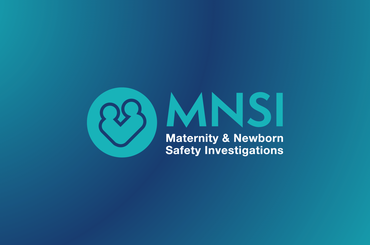Our Directions instruct us to investigate several types of maternity related incidents in England, including maternal deaths.
A maternal death is defined as “the death of a woman while pregnant or within 42 days of the end of the pregnancy from any cause related to or aggravated by the pregnancy or its management, but not from accidental or incidental causes.”
Our investigations provide MNSI a unique opportunity to better understand the experience of families involved in a maternal death. While MNSI investigations focus on safety learnings first and foremost, we nevertheless have an opportunity to discuss all aspects of care with families, including how they are supported after a maternal death.
To improve our practice and share learning across the healthcare sector, we organised focus groups with MNSI investigators with previous experience of investigating maternal deaths and recorded to their anecdotal evidence of family experiences.
Some of the main questions we wanted to explore were:
- Did experiences differ between families involved in a maternal death outside the maternity environment, e.g. at home, and those inside a maternity environment?
- Would a national maternal death bereavement pathway be beneficial similar to that for neonatal deaths for example?
(Roughly concurrent to our focus groups, the Royal College of Obstetricians and Gynaecologists (RCOG) published a good practice paper on managing a maternal death event. This good practice paper has guidance and suggested checklists for staff, which supports what we heard in the focus groups.)
Information from the focus groups suggests that there is a difference in the experience of families depending on where a maternal death occurred, but overall family experiences were not negatively affected by the location that a maternal death occurred.
MNSI investigator findings - training, pathways and impact on staff
Impact of variance in training
Families recognised that there were differing skill sets amongst staff depending on which area of the hospital they work. Within intensive care units and palliative care settings the experience of caring for families following an adult death was demonstrated in the careful messaging and information provided following a death. Within a high acuity area such as emergency departments, families received compassionate care, evident in the making of memory boxes for deceased babies. Due to the acuity of the emergency department environment, there was less confidence in the knowledge of the whole bereavement process.
The scope and breath of training impacted on families’ experiences. This was reflected by how staff communicated when these events occurred with a feeling that there was an emphasis on what was allowed to be said rather than ‘being human’.
Often advice was sought from the maternity team and in particular the bereavement midwives. This highlighted that training specific to maternal deaths provided to midwives (including the designated role of bereavement midwife) is limited. This is supported by the 2022 Sands survey which found 49% of trusts provided training to staff who come into contact with families experiencing pregnancy loss, with only 12% of those providing the training during daytime core hours.
The local bereavement training that was provided often focussed on the death of a baby. This an area where maternal death can be included with the training adapted to include areas such as financial considerations and benefits that may be applied for, care of the baby (if surviving the maternal death), registration of birth and deaths, and the recommendation that all maternal deaths were offered a postmortem examination.
Additionally, there appeared to be limited awareness amongst all health professionals regarding the MBRRACE recommendation that all maternal deaths should be offered a postmortem examination and, as such, many families were not offered a post mortem.
Referral pathways
Internal hospital pathways appear confused. In the cases of a maternal death in which the baby had been born alive, there was a referral to maternity for familial support. However, if the baby was not born then referral was to the hospital bereavement team. The focus of the bereavement team, support groups, and group counselling services was felt to be orientated to mothers following neonatal and stillbirth deaths with little support for partners following a maternal death.
Heightened tensions between a trust and a family in the wake of a maternal death can hamper access to bereavement or maternity teams, including the opportunity to provide effective psychological support. The family may decide not to accept the support, the trust might not actively promote the support, or expectations might be that support would be delivered by GP services. External or independent maternal death support groups were considered to have greater benefit, but there are very few available.
Families were informed about hospital bereavement teams and that contact would be made but felt that it was expected for GP services to provide support or counselling services. The wait for these services was perceived to be detrimental for families. External or independent maternal death support groups were considered to have greater benefit, but there are very few available.
Financial advice and support for partners following a maternal death was difficult and not well understood by trusts or other agencies. These difficulties are increased when parents are not married, and exacerbated further if there has been no legal provision considered. Available benefits tend to be confined to mothers, birthing persons, and not to a partner who may need the financial support and time away from work to care for a surviving baby. It was suggested that consenting processes may be adapted to support legal provisions in the event of a maternal death.
Impact on staff
Staff described that when a mother was transferred from maternity to a different department and a maternal death then occurred, there was limited consideration for the emotional and pastoral needs of the staff that had initiated care for the mother.
Staff providing direct care at the time of death may be involved in debriefing exercises but the holistic approach to a debrief was lacking. This increased the moral injury described by staff when they did find out about the maternal death some time later.
Towards a greater understanding
Greater understanding of the family and staff experience following a maternal death may assist further iterations of the RCOG good practice paper and wider learning. This understanding is best achieved through talking to families and staff. MNSI speaks with families and staff members to understand experiences and concerns as part of their investigations, this is focussed on an individual event and the systems and processes that impacted on safe care at that time.
There is an opportunity to expand the scope of maternal death investigations to capture the families experience after a maternal death. This would also assist in mitigating the trauma families and staff experience when repeatedly telling their story.
MNSI recognises that maternal deaths involve many different complexities meaning a national pathway is unlikely to assist staff or families. National guidance and specific training would assist families and staff to navigate the steps immediately following a maternal death more effectively.
Related news
Inspiring inclusion and empowering MNSI investigators

Why it made sense at the time: Local rationality questions for healthcare investigations

MSNI Ambitions for 2024
